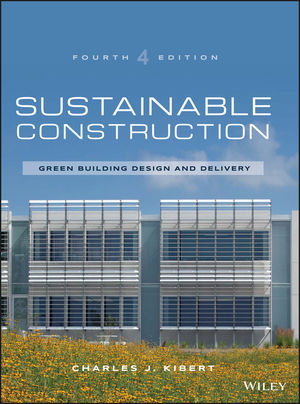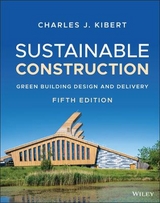
Sustainable Construction
John Wiley & Sons Inc (Verlag)
978-1-119-05517-4 (ISBN)
- Titel erscheint in neuer Auflage
- Artikel merken
The leading green building reference, updated with the latest advances in the field Sustainable Construction is the leading reference for the design, construction, and operation of high performance green buildings. With broad coverage including architecture, engineering, and construction, this book nevertheless delivers detailed information on all aspects of the green building process, from materials selection to building systems and more. This new fourth edition has been updated to reflect the latest codes and standards, including LEED v4, and includes new coverage of carbon accounting. The discussion has been updated to align with the current thinking on economics, climate change, net zero buildings, and more, with contributions by leaders in the field that illustrate the most recent shifts in thinking and practice. Ancillary materials including an instructor's manual and PowerPoint presentations for each chapter help bring this clear and up-to-date information into the classroom, making this book a valuable reference for working construction professionals. Also, Interactive graphics found throughout the course help activate the content and highlight key concepts for students.
Sustainable construction has gone mainstream, and will one day be the industry norm. This book provides a comprehensive reference to all aspects of a project to show you how green building concepts and principles apply throughout the design and construction process. * Get up to date on the latest green building codes and standards * Learn about the newest technology in green building materials * Adopt the best practices in procurement and delivery systems * Apply sustainability concepts to all aspects of construction and design Green buildings operate at a very high level of efficiency, which is made possible only by careful consideration every step of the way. Appropriate land use, landscaping, construction materials, siting, water use, and more all play a role in a structure's ultimate carbon footprint. Sustainable Construction provides clear guidance for all aspects of green building, including the most recent advances and the latest technology.
Charles Kibert Ph.D., P.E. is the Director of the Powell Center for Construction and Environment at the University of Florida and a professor in the M.E. Rinker Sr. School of Building Construction, where he organized and teaches the Sustainable Construction graduate track as well as continuing education. He is co-founder and president of the Cross Creek Initiative, a nonprofit industry/university joint venture bringing sustainability principles into the construction industry. Formerly co-chair of the Curriculum and Accreditation Committee of the U. S. Green Building Council, he is currently a chair of the iiSBE Net Zero Built Environment Working Group and a board member of the Green Building Initiative.
Foreword xiii Preface xv Chapter 1 Introduction and Overview The Shifting Landscape for High-Performance Buildings Sustainable Development and Sustainable Construction The Vocabulary of Sustainable Development and Sustainable Construction Sustainable Design, Ecological Design, and Green Design Rationale for High-Performance Green Buildings State and Local Guidelines for High-Performance Construction Green Building Progress and Obstacles Book Organization Trends in High-Performance Green Building Summary and Conclusions Notes References Part I Green Building Foundations Chapter 2 Background Ethics and Sustainability Basic Concepts and Vocabulary Major Environmental and Resource Concerns The Green Building Movement Case Study: OWP 11, Stuttgart, Germany Summary and Conclusions Notes References Chapter 3 Ecological Design Design versus Ecological Design Historical Perspective Contemporary Ecological Design Key Green Building Publications: Early 1990s Key Thinking about Ecological Design Evolving the Concept of Ecological Design Thermodynamics: Limits on Recycling and the Dissipation of Materials Case Study: Kroon Hall, Yale University, New Haven, Connecticut Thought Piece: Regenerative Development and Design: Working with the Whole by Bill Reed Summary and Conclusions Notes References Part II Assessing High-Performance Green Buildings Chapter 4 Green Building Assessment Major Green Building Assessment Systems Used in the United States International Building Assessment Systems BREEAM CaseStudy: AHVLA Stores Building, Weybridge, United Kingdom Green Star Case Study Thought Piece: Shifting Emphasis in Green Building Performance Assessment by Raymond J. Cole Summary and Conclusions Notes References Chapter 5 The US Green Building Council LEED Building Rating System Brief History of LEED Structure of the LEED Suite of Building Assessment Systems LEED Credentials LEED v4 Structure and Process LEED Categories152 Case Study: Research and Academic Center at Lake Nona, University of Florida, Orlando Summary and Conclusions Notes Chapter 6 The Green Globes Building Assessment System Green Globes Building Rating Tools Structure of Green Globes For New Construction Version 2 The Green Globes Assessment and Certification Process Green Globes Professional Credentials Case Study: Health Sciences Building, St. Johns River State College, St. Augustine, Florida Summary and Conclusions Note Part III Green Building Design Chapter 7 The Green Building Design Process Conventional versus Green Building Delivery Systems Executing the Green Building Project The Integrated Design Process Role of the Charrette in the Design Process Green Building Documentation Requirements Case Study: Theaterhaus, Stuttgart, Germany Summary and Conclusions Notes Chapter 8 The Sustainable Site and Landscape Land and Landscape Approaches for Green Buildings Land Use Issues Sustainable Landscapes Enhancing Ecosystems Stormwater Management Low-Impact Development Heat Island Mitigation Light Trespass and Pollution Reduction Assessment of Sustainable Sites: The Sustainable Sites Initiative Case Study: Iowa Utilities Board/Consumer Advocate Office Summary and Conclusions Notes References Chapter 9 Energy Reduction Building Energy Issues High-Performance Building Energy Design Strategy Passive Design Strategy Building Envelope Internal Load Reduction Active Mechanical Systems Water-Heating Systems Electrical Power Systems Innovative Energy Optimization Strategies Renewable Energy Systems Fuel Cells Smart Buildings and Energy Management Systems Ozone-Depleting Chemicals in HVAC&R Systems Case Study: River Campus Building One, Oregon Health and Science University, Portland Thought Piece: Building Energy Analysis: The Present and Future by Ravi Srinivasan Summary and Conclusions Notes References Chapter 10 Built Environment Hydrologic Cycle Global Water Resource Depletion Water Distribution and Shortages in the United States Hydrologic Cycle Terminology High-Performance Building Hydrologic Cycle Strategy Designing the High-Performance Building Hydrologic Cycle Water Budget Rules of Thumb (Heuristics) Sustainable Stormwater Management Landscaping Water Efficiency Case Study: LOTT Clean Water Alliance, Olympia, Washington Summary and Conclusions Notes References Chapter 11 Closing Materials Loops The Challenge of Materials and Product Selection Distinguishing between Green Building Products and Green Building Materials LCA of Building Materials and Products Environmental Product Declarations Materials and Product Certification Systems Key and Emerging Construction Materials and Products Design for Deconstruction and Disassembly Case Study: Project XX Office Building, Delft, Netherlands Thought Piece: Closing Materials Loops by Bradley Guy Summary and Conclusions Notes References Chapter 12 The Built Environment Carbon Footprint Human Impacts On The Biogeochemical Carbon Cycle Climate Change And The Carbon Cycle Mitigating Climate Change Defining The Carbon Footprint Of The Built Environment Reducing The Carbon Footprint Of The Built Environment Notes References Chapter 13 Indoor Environmental Quality Indoor Environmental Quality: The Issues Integrated IEQ Design Addressing the Main Components of Integrated IEQ Design HVAC Systems Design Emissions from Building Materials Particleboard And Plywood Economic Benefits of Good Indoor Environmental Quality Summary and Conclusions Notes References Part IV Green Building Implementation Chapter 14 Construction Operations and Commissioning Site Protection Planning Managing Indoor Air Quality during Construction Construction Materials Management Construction and Demolition Waste Management Commissioning Thought Piece: The Role of Commissioning in High-Performance Green Buildings by John Chyz Summary and Conclusions Notes References Chapter 15 Green Building Economics General Approach The Business Case for High-Performance Green Buildings The Economics of Green Building Quantifying Green Building Benefits Managing First Costs Tunneling through the Cost Barrier Summary and Conclusions Notes References Chapter 16 The Cutting Edge of Sustainable Construction Passive Survivability Cutting Edge: Case Studies Case Study: The Federal Building, San Francisco, California Articulating Performance Goals for Future Green Buildings The Challenges Revamping Ecological Design Today s Cutting Edge Case Study: Green Skyscrapers Thought Piece: Processes, Geometries, and Principles: Design in a Sustainable Future by Kim Sorvig Summary and Conclusions Notes References Appendix A Quick Reference for LEED 3.0 Appendix B The Sustainable Sites Initiative (SITES ) Guidelines and Performance Benchmarks 2009 Appendix C Unit Conversions Abbreviations and Acronyms Glossary Index
| Erscheint lt. Verlag | 27.5.2016 |
|---|---|
| Verlagsort | New York |
| Sprache | englisch |
| Maße | 218 x 283 mm |
| Gewicht | 2200 g |
| Themenwelt | Technik ► Architektur |
| Technik ► Bauwesen | |
| ISBN-10 | 1-119-05517-2 / 1119055172 |
| ISBN-13 | 978-1-119-05517-4 / 9781119055174 |
| Zustand | Neuware |
| Informationen gemäß Produktsicherheitsverordnung (GPSR) | |
| Haben Sie eine Frage zum Produkt? |
aus dem Bereich



